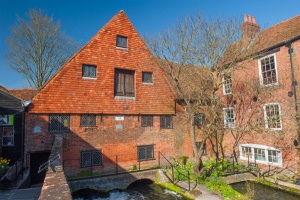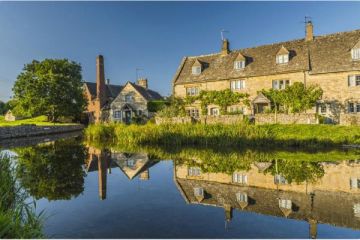
City Mill is a restored water mill, built in 1743 to replace an earlier medieval mill used for grinding corn. City Mill is unusual in being located almost in the heart of Winchester, whereas most mills are well away from urban areas. The mill stands astride the River Itchen on the north side of Bridge Street, a few short paces from the statue of King Alfred on the Broadway.
History of City Mill
There has been a mill on this site since the Saxon period; in AD 939 Queen Elfrida granted the mill to the Benedictine nuns of Wherwell Abbey. The nuns did not use the mill themselves but leased it to a succession of millers. This early mill was known as Eastgate Mill, being close to the city's East Gate (near the place that King Alfred's statue now stands on Broadway).
The mill was recorded in the Domesday Book of 1086, when it returned an annual rent of 48 shillings to the Abbess of Wherwell, well above the value of similar mills. The mill continued to prosper well into the 13th century; records for 1295 show that the tenant miller, a man named William, paid 4 pounds of silver on a 7-year lease. In return, the abbess promised to supply 'any great timbers' the mill needed.

Unfortunately, that early medieval prosperity would not last. The 14th century saw a gradual climate change, resulting in a succession of poor harvests, so naturally, there was less corn to grind into flour. Then the Black Death of 1348 decimated the population and the mill's importance declined still further.
The final blow was a downturn in the wool trade in the late 15th century. Calais took over from Winchester as the leading port for exporting English wool to the continent, and the city's economy suffered. The mill was used less and less and was recorded as being in a semi-derelict condition by 1417.
When the Wherwell nunnery was dissolved in 1539 by Henry VIII Eastgate Mill passed to the crown, but it did not stay in royal hands long. In 1554 Queen Mary gave the mill to the City of Winchester as part payment for her wedding to Philip of Spain, which was held at Winchester Cathedral. Given the decayed condition of the mill, one wonders how welcome this 'gift' was! This is the first time that the name 'City Mill' is used.

The City leased out the mill, but could not afford to restore the building, so they could only get a small rental fee. In 1662 this was 10 shillings annually and 2 chickens to the Mayor. Though the terms of the lease required the mill tenants to rebuild the structure, nothing was done and the building continued to decay.
Then in 1743 help arrived in the form of James Cook, a tanner of Soke (just south and east of the river) who leased the building and rebuilt it, incorporating the roof timbers of the earlier medieval building
Cook's mill is an attractive building of brick, topped with a gabled roof hung with tiles. City Mill seems to have been used specifically for milling flour rather than as a general-purpose mill. In 1820 the mill was sold to John Benham, and the Benham family owned it for the next century
The Benhams tried unsuccessfully to sell the mill in 1892, but it remained in operation until the early 20th century. It was used as a laundry during World War I, then in 1928 it was threatened with destruction until a local group purchased the building and granted it to the National Trust.
The Trust let the building to the Youth Hostel Association, but in 1992 the Trust embarked on an ambitious restoration programme that took 12 years to complete. The fully restored and working mill opened to the public in 2004 and holds regular milling demonstrations for visitors.

When the Wherwell nunnery was dissolved in 1539 by Henry VIII the mill passed to the crown, but it did not stay in royal hands long. In 1554 Queen Mary gave the mill to the City of Winchester as part payment for her wedding to Philip of Spain, which was held at Winchester Cathedral. Given the decayed condition of the mill, one wonders how welcome this 'gift' was!
The City leased out the mill, but could not afford to restore the building, so they could only get a small rental fee. Then in 1743 help arrived in the form of James Cook, who leased the building and rebuilt it, while incorporating bits of the earlier building. Cook's mill is an attractive building of brick, topped with a gabled roof hung with tiles. City Mill seems to have been used specifically for milling flour rather than as a general-purpose mill.
The mill remained in operation until the early 20th century, and was later used as a laundry during World War I. In 1928 it was threatened with destruction until a local group purchased the building and granted it to the National Trust.

The Trust let the building to the Youth Hostel Association, but in1992 the Trust embarked on an ambitious restoration programme that took 12 years to complete. The fully restored and working mill opened to the public in 2004 and holds regular milling demonstrations for visitors.
Otters on the Itchen
In 1994 1 male and 2 female otters were released in the River Itchen. The otters successfully established themselves on the river, and since then other otters have moved into the area from the west.
The otters chose the area around the mill to come ashore and mark their territory. In 2006 the National Trust, in partnership with the local Wildlife Trust and the Environmental Agency, set up a system of motion-sensitive cameras to monitor otter movements and allow visitors to glimpse these elusive creatures.
The 'otter cam' is activated whenever an otter (or any other small creature) appears, and a video sequence is captured. This has proven to be a very popular feature at City Mill, and some people visit just to watch the otter cams!
Visiting City Mill
Downstairs, a torrent of water rushes through a narrow space, and you can cross over the mill race on metal decking to view the water wheel and gearing turn the millstones. Upstairs, the wheat is fed through a hopper on to the millstones and is ground into flour. The resulting stoneground flour can be purchased in the shop.
The best time to visit is when the mill is actually running, but the displays include models and explanations of the process. There is also an interesting video of the history of the mill. There are demonstrations of flour milling every Saturday and Sunday throughout most of the year.
In addition to the milling machinery, there are displays about the River Itchen ecology and its wildlife, including webcam footage of the otters who use the mill on their travels up and down the river.
About Winchester City Mill
Address: Bridge Street,
Winchester,
Hampshire,
England, SO23 9BH
Attraction Type: Museum
Location: On the north side of Bridge Street and the eastern end of The Broadway (near the King Alfred statue)
Website: Winchester City Mill
Email: winchestercitymill@nationaltrust.org.uk
National Trust - see also:
National Trust memberships (official website link)
Location
map
OS: SU478296
Photo Credit: David Ross and Britain Express
HERITAGE
 We've 'tagged' this attraction information to help you find related historic attractions and learn more about major time periods mentioned.
We've 'tagged' this attraction information to help you find related historic attractions and learn more about major time periods mentioned.
Historic Time Periods:
Find other attractions tagged with:
13th century (Time Period) - 14th century (Time Period) - 15th century (Time Period) - Domesday Book (Historical Reference) - Henry VIII (Person) - Medieval (Time Period) - Queen Mary (Person) - Restoration (Historical Reference) - Saxon (Time Period) -
NEARBY HISTORIC ATTRACTIONS
Heritage Rated from 1- 5 (low to exceptional) on historic interest
Westgate Museum - 0.1 miles (Museum) ![]()
Winchester Castle - 0.2 miles (Castle) ![]()
Queen Eleanor's Garden - 0.2 miles (Garden) ![]()
Royal Green Jackets (Rifles) Museum - 0.2 miles (Museum) ![]()
The Gurkha Museum - 0.2 miles (Museum) ![]()
Kings Royal Hussars Museum - 0.2 miles (Museum) ![]()
Royal Hampshire Regiment Museum - 0.2 miles (Museum) ![]()
Winchester City Museum - 0.2 miles (Museum) ![]()
Nearest Holiday Cottages to Winchester City Mill:
Meonstoke, Hampshire
Sleeps: 15
Stay from: £1863.00 - 10808.00
More self catering near Winchester City Mill










